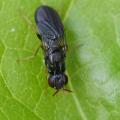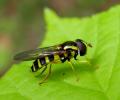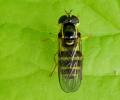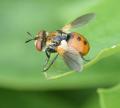|
Bombus terrestris/vestalis ?
|
|
| Alvesgaspar |
Posted on 26-01-2008 20:08
|
|
Member Location: Posts: 571 Joined: 24.08.07 |
I'm posting two pictures which I first thought were of the same species of bumblebee: Bombus terrestris. But I doubt it now because the first (about 20mm) is much larger than the second (12-15mm). Am I right Christian?  Thanks, Joaquim Gaspar Lisboa Edited by Alvesgaspar on 27-01-2008 12:40 |
|
|
|
| Alvesgaspar |
Posted on 26-01-2008 20:09
|
|
Member Location: Posts: 571 Joined: 24.08.07 |
here is the other one... |
|
|
|
| jorgemotalmeida |
Posted on 26-01-2008 20:23
|
|
Member Location: Posts: 9295 Joined: 05.06.06 |
this afternoon I saw many syrphids, one new for me (and awesome) and plenty Bombus spp.! They are everywhere.  No signal of Myopas.   |
|
|
|
| Alvesgaspar |
Posted on 26-01-2008 20:32
|
|
Member Location: Posts: 571 Joined: 24.08.07 |
I think the climate changes are fooling Nature. Both plants and insects are convinced that spring has come! |
|
|
|
| Rui Andrade |
Posted on 26-01-2008 21:00
|
|
Member Location: Posts: 3122 Joined: 19.06.07 |
This winter I saw plenty of Coccinella septempunctata, I don't recall seeing so many at this time of the year. |
|
|
|
| jorgemotalmeida |
Posted on 26-01-2008 21:24
|
|
Member Location: Posts: 9295 Joined: 05.06.06 |
The flies are coming  Today I saw many flowers blooming. I will try to go see "amendoeiras" in flower... 
Edited by jorgemotalmeida on 26-01-2008 21:26 |
|
|
|
| Susan R Walter |
Posted on 26-01-2008 22:38
|
|
Member Location: Posts: 1794 Joined: 14.01.06 |
I think the top one is B vestalis.
Susan |
|
|
|
| Alvesgaspar |
Posted on 27-01-2008 12:38
|
|
Member Location: Posts: 571 Joined: 24.08.07 |
Susan R Walter wrote: I think the top one is B vestalis. Thank you, Susan, but are you sure? My book (Chinery) says that cucko bees generally resemble the species thay parasite and that B. vestalis parasites B. terrestris (till now everything matches). But also says that the coats are less dense so that abdominal plates shine through. Furthermore, there shouldn't a difference in size so large. I'm posting another view, maybe more details are visible. |
|
|
|
| Susan R Walter |
Posted on 27-01-2008 15:40
|
|
Member Location: Posts: 1794 Joined: 14.01.06 |
B vestalis queens can be very big, and very plush looking. It can also emerge quite early. Your specimen is clearly of a cuckoo species (no corbicula, darkened wings). The only thing that makes me doubt is the quantity of tawny hairs on the scutellum, but I don't know what else it could be (but bear in mind that you have lots of species that I have never seen too). I am assuming you took these photos in the last couple of days? But if not, that could give clues to the ID as well.
Susan |
|
|
|
| Alvesgaspar |
Posted on 27-01-2008 18:43
|
|
Member Location: Posts: 571 Joined: 24.08.07 |
The photos were taken a couple of days ago. Anyway, they are everywhere now. And also lots of B. terrestris , Xylocopa violacea and honey bees. I even saw Polistes wasps. Climate changes are fooling the poor things... With yellow hair on the sculetum, could it be instead a B. barbotellus (parasite of B. hortorum)? |
|
|
|
| cthirion |
Posted on 27-01-2008 19:03
|
|
Member Location: Posts: 901 Joined: 13.08.04 |
Photo two....corbicula present!!!!!!!! I think vestalis for photo number One cthirion |
|
|
|
| Alvesgaspar |
Posted on 27-01-2008 19:33
|
|
Member Location: Posts: 571 Joined: 24.08.07 |
Yes, photo 2 is supposed to be a B. terrestris. The problem is with photos 2 an 3: B. vestalis or B. barbotellus? |
|
|
|
| Susan R Walter |
Posted on 27-01-2008 19:57
|
|
Member Location: Posts: 1794 Joined: 14.01.06 |
The size and clarity of the yellow flash on the side of the abdomen indicates vestalis rather than barbutellus, and barbutellus is generally more scruffy looking with sparser hair (in the way that Chinnery describes).
Susan |
|
|
|
| Christian Schmid-Egger |
Posted on 27-01-2008 20:03
|
|
Member Location: Posts: 233 Joined: 05.08.05 |
I am not sure about the first species, but B. vestalis is probable. In any case, it is a former Psithyrus member. Second photo ist one of the terrestris/lucorum species. Regards, Christian |
|
|
|
| Alvesgaspar |
Posted on 27-01-2008 20:18
|
|
Member Location: Posts: 571 Joined: 24.08.07 |
So B. vestalis be! Thanks to Susan, Christian and cthirion  |
|
|
|
| Roderick Peter Macfarlane |
Posted on 27-01-2008 21:59
|
|
Member Location: Posts: 1 Joined: 15.12.07 |
Dear Jaquim, The main reson for the difference in size in bumle bees is that the queens, which emerge in spring are much larger than workers or males. In Portugal like New Zeland there can be more than one generation of species like Bombus terrestris. Queen bumble bees can wieigh up to a gram from memeory and to overwinter successfully they need about 20% of more of their body weight to be in fat, to ensure they can live through for the about 10 months needed to raise the next lot of new queens. The second photo with a slight yellow places ID in the terrestritirs group in slight doubt and the lower face is too much in the flower in both shots to judge if they have the sort malar space of B. terrestris etc. or the long tongued species, which for instance trend to favour foraging on deeper flowers like Labiatae and honey suckle or red clover. I worked on bumble bees and their ecolgy in the 1970-1980's including determination of their commercial value for red clover pollination. The white colouring on the abdomen of your specimens distinguishes this species from the variety present in Great britain, New Zealand and tasmania as queens. Rod Macfarlane My work to date has centred on insect community studies and writing overviews of New Zealand Diptera. I have also done considerable volunteer work sorting Diptera here to family and beyond and preparing my own ID manuals for various larger families. Some of this work and hopefully a begining to taxonomy will be published in the next few years. Rod Macfarlane |
|
|
|
| Alvesgaspar |
Posted on 27-01-2008 23:58
|
|
Member Location: Posts: 571 Joined: 24.08.07 |
Thank you for the information (and lesson...), Rod. The bumblebee in photo 2 , which is quite common here and I've always identified as a B. terrestris, has indeed a long tongue, as you can see in this new picture. Does it mean it is really a B. terrestris? Joaquim Edited by Alvesgaspar on 28-01-2008 00:00 |
|
|
|
| Christian Schmid-Egger |
Posted on 28-01-2008 11:08
|
|
Member Location: Posts: 233 Joined: 05.08.05 |
Sorry, but I never heard that lenght of glossa (tongue) or of malar space is a distinction character within the Bombus terrestris/lucorum group. As far as I know, queens (ony) can be recognized by some details in color pattern and by puncture of head and last tergum. Workers are not distinghuishable, and males are nearly impossible to distinghuish. B. terrestris is a more or less dark species, whereas the others are lighter. But I am not able (or never tried it seriouly) to identify the four species in this group. My knowledge comes from a scientific presentation last year, and there are some recent examinations and publications about the terrestris/lucorum group. Separation to former Psithyrus species works by less dense hairiness, lack of collecting facilities on hindlegs and other characters in (former) Psithyrus. Regards, Christian Regards, Christian |
|
|
|
| Jump to Forum: |













